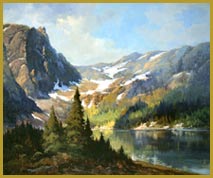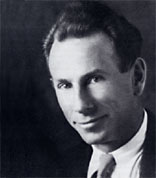|
|
|
|
|
|
|
|
In
the memories of many of his fans and collectors, Robert Wood is
indelibly linked with the Bohemian art colony of Laguna Beach, California.
Although Wood only lived in Laguna Beach for a little more than
a decade, it was probably his most productive period, and when he
reached the peak of his fame. Furthermore, dealers like Larry Kronquist
of Kronquist Galleries and Richard Challis of Challis Galleries
continued to sell Wood's work in the coastal resort long after his
departure. even today, Laguna Beach dealers who specialize in historic
paintings actively seek out and sell works by Robert W. Wood.
Robert
Wood almost certainly visited Laguna during one of his early periods
in California, at some point during the 1910s or 1920s. He was drawn
to the area by its climate, the variety of landscape and marine
subjects, and its reputation as an art colony that collectors were
attracted to. Wood also spent some time there in the mid 1940s,
after he had moved to California.
The
available evidence indicated that he did not move there permanently,
however, until after World War II. Once there, Wood painted many
scenes of the ocean, usually from one of the many beaches that offered
vantage points for the painter. Today collectors find many of these
titled with the names of the coves near Laguna - Moss Cove, Wood's
Cove or Capistrano Beach.
In
the memories of many viewers, Robert Wood's name will forever be
linked with Laguna's famous Festival of the Arts. The first Laguna
Festival was held in 1932 on El Paseo, a short street near the Laguna
Hotel. By the time Wood moved to Laguna, the festival had relocated
to its current location on Laguna Canyon. At the festival, regional
artists display their work in a permanent outdoor setting, and thousands
of collectors come to view and purchase paintings and meet the artists.
Wood
first exhibited at the Laguna Festival in 1948 and immediately became
one of its main attractions. From 1949 to 1951, when he moved east
to the Catskills' art colony of Woodstock, New York, he didn't participate,
but upon his return to Laguna in 1951, he became an active exhibitor.
During the festival, which lasted a number of weeks, Wood replaced
works as he sold them, often going through dozens of paintings.
All told, wood exhibited at the festival in 1948, 1951-1955, 1957
and finally in 1959. These works were often sold to out-of-state
purchasers who gave the artist a small down payment and then made
montly payments.
In
the early 1950s, after Wood was divorced from Tula and returned
to Laguna, he actually lived in the guest house of the home she
shared with her wealthy new husband in Capistrano Beach. Once he
became settled he moved to Laguna itself. After a serious car accident
in 1953 he met Caryl Price, a divorcee and fellow artist, and the
two were soon married. They lived in Laguna until 1959, when the
couple purchased a home in Bishop, beneath the majestic Sierras.
Even after his move to the mountains, Wood continued to paintscenes
of Laguna Beach from reference and his vivid memory, and in the
minds of many collectors, the two will be forever linked.
|
|



